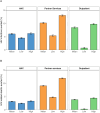Comparison of HIV self-test distribution modalities to reduce HIV transmission and burden in western Kenya: a mathematical modelling study
- PMID: 40744510
- PMCID: PMC12314966
- DOI: 10.1136/bmjopen-2025-102999
Comparison of HIV self-test distribution modalities to reduce HIV transmission and burden in western Kenya: a mathematical modelling study
Abstract
Objectives: To compare the impact of different HIV self-testing (HIVST) distribution modalities on population-level HIV outcomes.
Design: Mathematical modelling study.
Setting: Six counties in western Kenya.
Methods: We projected population-level HIV outcomes among individuals aged 15+over 30 years (2022-2052) using EMOD-HIV, an agent-based network transmission model calibrated to the HIV epidemic in western Kenya. We simulated the impact of three HIVST distribution modalities: (1) secondary distribution to male partners via women who attend antenatal care visits ('ANC'); (2) secondary distribution to partners of individuals newly diagnosed with HIV at health facilities ('partner services'); and (3) distribution to any individuals attending outpatient clinics ('outpatient'). We informed our model assumptions on HIV testing uptake for each HIVST distribution modality using the estimates from a meta-analysis of randomised clinical trials published between 2006 and 2019 and compared the outcomes for each HIVST distribution modality to standard testing without HIVST.
Outcomes measures: The number of HIV tests performed (HIVST and non-HIVST), HIV diagnoses, HIV infections, and HIV-related deaths.
Results: With standard testing alone, the average number of HIV tests was 4.69 million per year, amounting to 81.0 tests per 100 adults. The average number of tests per year increased by 2.9% with ANC, 0.6% with partner services, and 23.7% with outpatient distribution of HIVST. Compared with standard testing alone, partner services with HIVST will avert the largest number of new HIV infections (10.2%, 95% CI 9.9% to 10.5%), followed by outpatient distribution (8.5%, 95% CI 8.2% to 8.7%) and ANC (6.1%, 95% CI 5.8% to 6.3%). Compared with standard testing, the number of HIVST needed per one additional HIV infection averted was 216 with ANC, 17 with partner services and 2009 with outpatient, while the number of HIVST per one additional HIV-related death averted was 364 with ANC, 17 with partner services and 3851 with outpatient.
Conclusions: Secondary distribution of HIVST to partners of individuals newly diagnosed with HIV could prevent the most HIV infections and HIV-related deaths. HIVST can be an important strategy to improve uptake of testing and long-term population-level health effects.
Keywords: Africa South of the Sahara; Epidemiology; HIV & AIDS.
© World Health Organization 2025. Licensee BMJ.
Conflict of interest statement
Competing interests: None declared.
Figures



References
-
- UNAIDS Prevailing against pandemics by putting people at the centre — world aids day report 2020. 2020 https://www.unaids.org/en/resources/documents/2020/prevailing-against-pa... Available.
-
- National AIDS and STI Control Programme (NASCOP) Nairobi: NASCOP; 2022. Kenya population-based HIV impact assessment (KENPHIA) 2018: final report.
-
- World Health Organization . Geneva: World Health Organization; 2016. Guidelines on HIV self-testing and partner notification: supplement to consolidated guidelines on HIV testing services. - PubMed
Publication types
MeSH terms
Grants and funding
LinkOut - more resources
Full Text Sources
Medical
